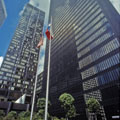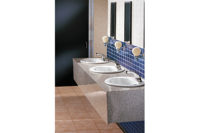
Through a series of renovations over a
multi-year period, 1 Houston
Center earned a LEED EB: O & M Gold rating. Photo courtesy of Crescent Real
Estate.
1 Houston Centerwas typical of late 1970s design. Water and energy took a backseat to durability, reliability and flexibility.
Located in the heart of Houston’s central business district, the 48-story, 1.3 million-sq.-ft. high-rise was designed as the world headquarters of the Texas Eastern Pipeline Co.
But it wasn’t until the mid-1990s that conservation of energy and natural resources was highly regarded. At the time, though, the business climate was not ready to invest down that road. Instead, the building stuck to its policy of extending the life of existing equipment, which consumed water to the tune of 35 million gallons per year.
In 1998,Crescent Real Estate purchased the building and its engineers decided to begin an aggressive plan toward reducing water consumption - one that eventually led the building to earn the U.S. Green Building Council’s Leadership in Energy and Environmental Design Gold distinction in the Existing Buildings: Operations and Maintenance category.
Starting Simple
In 2002, bathrooms started to be equipped with hands-free faucets. Three years later, TOTO sensor faucets and Total Concepts AutoFlush mechanisms, attached to the Sloan flushometers, made their way into restrooms and further advanced the green process, as did the installation of low-flow (0.2-gpm) aerators on faucets. The cost was $5,000 to convert each of the 48 floors with all work done in-house.That first step saw water usage reduced 20% or 27.8 gallons per occupied square foot. Engineers were pleased, but looked for more to change.
“We needed a road map,”Dale Roane, the building’s assistant chief engineer, says. “If we don’t know where we are, we’ll never know where we are going.”
In 2007, submeters and landscape irrigation were installed. The following year, Crescent became intrigued by the U.S. Green Building Council’s LEED initiative.
“Once we understood the requirements for water conservation credits we were given the green light to move further for additional savings,” Roane states.
So began the biggest in-house retrofit done in the history of 1 Houston Center. In two years, engineers replaced every commode and many of the urinals with low-flow models. The original 4.5-gpf toilets and 2.0-gpf urinals were replaced with Kohler 1.6-gpf commodes and Kohler 1.0-gpf urinals.
The replacement began slowly because the original mounting bolts were not long enough to hold the heavier wall units. Engineers found a modified “off the shelf” carrier nut that was narrower, deeper and more acceptable for the new shortened bolt.
With that problem solved, the transformation kicked into a higher gear. After two years with overtime weekends, the building had cut down from 27.29 gallons per occupied square foot to almost 24 gallons per occupied square foot.
More Work To Do
Two projects remained to complete the water conservation program. First, was a complete redesign of the landscape to native and adaptive vegetation. Doing this met another LEED EB: O&M credit. Engineers, along with landscape contractor Silversand Services, opted to remove the conventional pop-up spray heads, which measured at 14 gpm and installed Techline micro-drip irrigation. A Weathermatic SmartLine controller and an onsite SmartLine weather station also helped contribute to a 20-psig decrease in water pressure and a 72% reduction in water flow.The final project improved the performance of the cooling tower cycles. 1 Houston Center operated between 3 1/2 and 5 cycles of concentration, but with a switch to an acid-based system, engineers wanted the system to run at 8 cycles. With water treatment partner ChemCal providing guidelines, Roane designed the new water treatment facility. Almost one year later, they reached their goal of 8 cycles.
After seven years, the overall water usage dropped from 34.56 gallons per occupied square foot to 21.99 gallons per occupied square foot - a reduction of 36%.
“Blue is the new green,” Roane says. “We’re ready for anything.”


